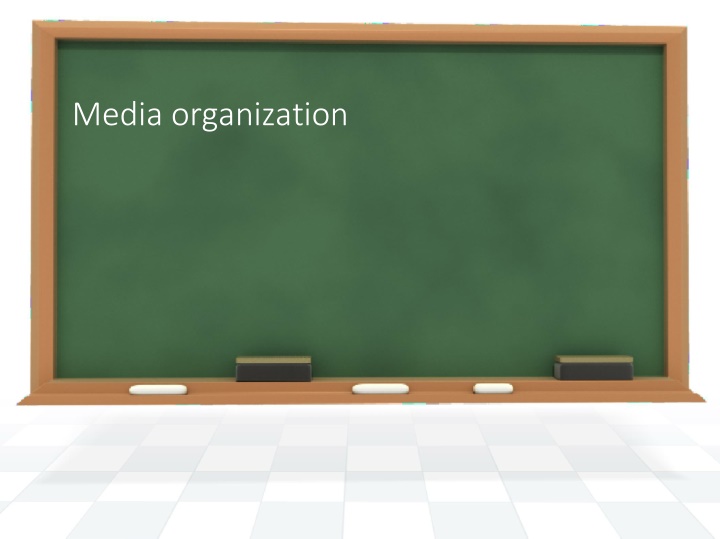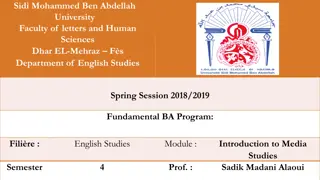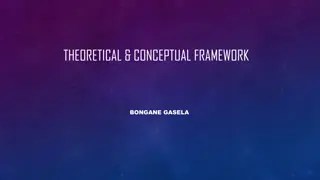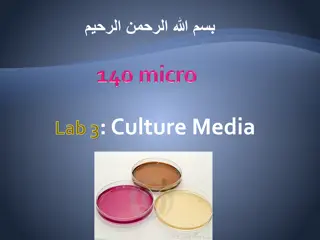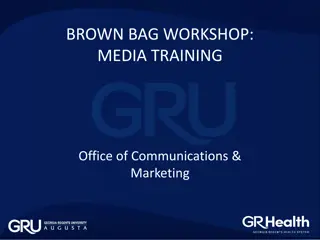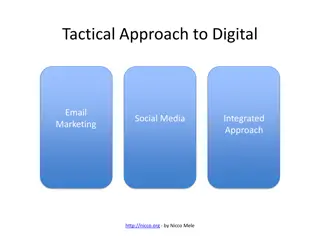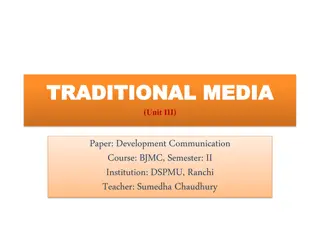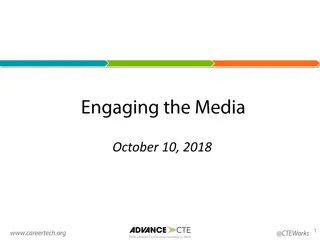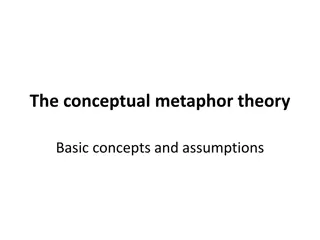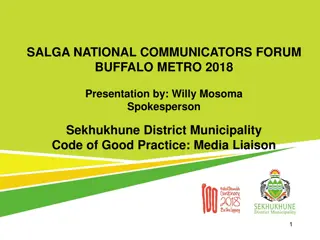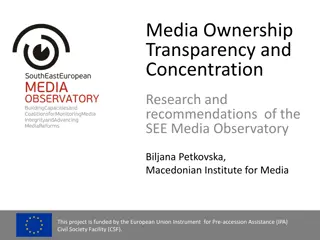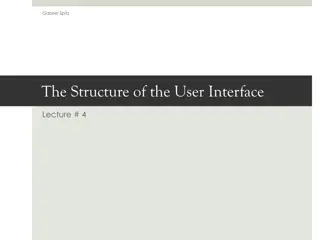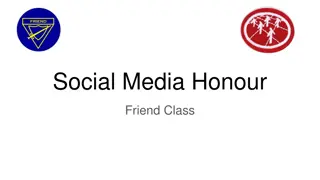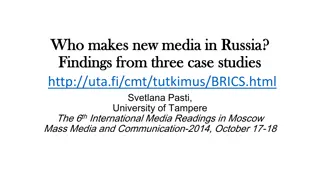Media Organization and Design: Conceptual Issues and Business Perspectives
Intricate landscape of media organization and design, from conceptual frameworks to practical applications. Dive into topics such as media entrepreneurship, organizational behavior, economics of media, project management, and programming strategies. Discover the diverse facets of mass media and the role of organizations in delivering information and entertainment to large audiences. Gain insights into the structure, function, and culture of media organizations, along with essential management themes and production processes.
Download Presentation

Please find below an Image/Link to download the presentation.
The content on the website is provided AS IS for your information and personal use only. It may not be sold, licensed, or shared on other websites without obtaining consent from the author.If you encounter any issues during the download, it is possible that the publisher has removed the file from their server.
You are allowed to download the files provided on this website for personal or commercial use, subject to the condition that they are used lawfully. All files are the property of their respective owners.
The content on the website is provided AS IS for your information and personal use only. It may not be sold, licensed, or shared on other websites without obtaining consent from the author.
E N D
Presentation Transcript
Syllabus Unit I Media Organization and Design: Some Conceptual Issues. Media as Business and Social Institution. Media entrepreneurship, Greiner's Development Model of a company. Unit II Behavior in media Organization and Organizational Behavior. Nature and Structure of different Media Organizations-AIR/DD, Private Satellite Channels, Production Houses, employment opportunities in Indian Media industry, Group Behavior, Innovation and Creativity, Culture of organization Unit III Economics of Media-Relationship between supplier and buyer, Leisure time activity, Cost Factors, Revenue Models, Market Factors, State of the Industry today. Unit IV Project Management in Media-Production Project Cycle (PPC), Management themes in production Process, Project Planning, Production Strategies, PPC in Practice-Initiation (Ideas, Evaluation and Assessment), Risk and Impact Assessment, Pre-production, Production Team, Project Specification, Project work plan, Sources of Funds, Budgeting (tols etc.) Project Responsibility, Production Process (status Report, Assessment, Negotiation, Completion, Follow-up. Unit V Programming Strategies, Audience Rating-Analyzing Programming and Audience Trends Marketing Programs arid selling space and time. Different kinds of contracts and legal arrangements, Project Management.
UNIT I Media Organization and Design: Some Conceptual Issues. Media as Business and Social Institution. Media entrepreneurship, Greiner's Development Model of a company.
MASS MEDIA Mass media is a term used to denote the section of the media specifically conceived and designed to reach a very large audience such as the population of a nation state. It was coined in the 1920s with the advent of nationwide radio networks, mass-circulation newspapers and magazines Media (the plural of "medium") refers to those organized means of dissemination of fact, opinion, entertainment, and other information, such as newspapers, magazines, out-of-home advertising, cinema films, radio, television, the World Wide Web, books, CDs, DVDs, videocassettes, computer games and other forms of publishing
ORGANISATION An organization is a social arrangement which pursues collective goals, which controls its own performance, and which has a boundary separating it from its environment. The word itself is derived from the Greek word organon meaning tool. "organization" is understood as planned, coordinated and purposeful action of human beings to construct or compile a common tangible or intangible product. This action is usually framed by formal membership and form (institutional rules).
Some views of organisation: Organisation is a system of structures and function. Organisation is structure in action over time. Organisation is an input/output system. Organisation is a cultural product. Organisation is a processing system. Organisation is a structure of sub-groups. Organisation is an exchange agent with its environment.
MEDIA ORGANISATION The organisation involved in production, distribution and exhibition of content through mass media constitute a media organisation It could be film production unit, television production company, advertising agency, PR agency, News paper agency, television channels, web portals etc. These organisations are mainly involved in producing content for their audiences.
Types of media Based on technology electronic media, print media, new media Based on reach National, regional, local Based on function News, entertainment, advertising
WHO CONTROLS MEDIA ORGANIZATION Media owners The state and the law Self regulation by media Economic determinants Advertisers Audience Media personals Media sourses
MEDIA OWNERSHIP Cross media ownership different media(TV + Radio + News paper) owned by one owner( Eg: sun network sun TV, Suryan FM, Dinakaran, Kungumam.) Horizontal concentration same media( Eg: news papers, magazines) owned by the same owner( Eg: times of india + economic times + navbharath times etc.) Vertical concentration Where ownership control various media institutions like production houses, channels and distribution channels( Zee TV, Zee Telefilms, Zee City-cable)
ORGANIZATION DESIGN The term organizational design refers to the different parts of the organization and the separate elements that are brought together to create it, and considers how these fit together and ways in which they may be analyzed and improved. The design aspects include how the organization is structured the typed and numbers of jobs, and the process and procedures used to: handle and pass information. Make decisions. Produce results. Manage quality. Communicate information. Plan, develop and manage resources. Innovate and handle crisis.
Internal structure and dynamics There are different sources of division within the boundaries of the organization. One impact is the diversity of function like news, entertainment or advertising. Each section has different interests and they compete for status and finance. Secondly, the personnel of M.O belong to different socio economic backgrounds.
Media organizational relationship The M.O has some kind of relationship with the following Society With owners, suppliers and clients Pressure groups (religious, political bodies) Internal public audience
MEDIA AS BUSINESS OR SOCIAL INSTITUTION Utilitarian organizations aims to produce or provide material goods or services for financial ends Normative organizations aims to advance some value or achieve a valued condition, based on the voluntary commitment of its participants.
Organization structure Structure refers to the way the organization is organized and in particular to the grouping of function and lines of communication and control. It is the frame work which explain how an organizations resources are allocated and managed. These are usually shown as lines on an organization chart, commonly called a familytree or an organgram . This formal structure lays down who has the authority to make decisions and to whom individuals report. The informal structure is what happens in practice. Individuals may sometimes bypass the person they are supposed to report to or vice versa. The main purpose of the structure is to ensure that the organization is designed in the best way to achieve its goal and objectives. While structure exists in organization of all sizes, issues relating to its design become significant when a certain size and complexity are reached, this can happen even at a very early stage.
Purpose of the organization structure To support the organizations strategy. To organize resources in the most efficient and effective way. To provide for the effective division of tasks and accountabilities among individuals and groups. To ensure effective coordination of the organization s activity and classify the decision making processes. To enhance the clarity of the lines of communication up, down and across the organization. To allow for the effective monitoring and review of the organization activities. To provide mechanism for coping with change in markets products and the intervals external environment. To facilitate the handling of crisis and problems. To help to motivate, manage and give job satisfaction to individual members of the organization. To provide for management succession.
Effects of poor organization structure: Poor motivation and morale. Ineffective decision making A lack of co-ordination and control. No adherence to corporate objectives Poor communication Divisiveness & lack of co-ordination, with everyone trying to protect their own domains. Higher costs and inefficiency An ability to respond effectively to changing conditions or to innovate Duplication of certain activities & possibly failure to undertake others. Failure to provide suitable opportunities for the development of future manager.
Media organization levels of analysis: The main levels and associated sources of influence are: Supra national (international, multinational) Society(Govt, social institution) Media industry (competing media business) Intra organizational (departments in organization) Individual (role, social background, attitude, gender)
MEDIA AS BUSINESS Media organisations are established mainly to make money by the following ways: Selling space and time Through circulation and distribution By creating content for media Through advertisements and advertorials By creating the advertisements itself
Media As Social Institution The social institutional aspect of media is concerned with the distribution of power in society and the domination of certain interests over others. Clearly, the media are a major player in this ideological struggle. Most critical communication theories are concerned with mass media primarily because of the media s potential for disseminating dominant ideologies and theirs potential for expressing alternative and oppositional ones. For some critical theorists, media are part of a culture industry that literally creates symbols and images that can oppress marginalized groups.
OBJECTIVES OF MEDIA AS A SOCIAL INSTITUTION Promoting national integration Safeguarding citizens rights Paying special attention to field of education Contributing to the growth of agriculture Providing environmental exposure Adequate coverage to Rural development Health and family welfare Science and technology Culture and heritage Empowerment of marginalized communities
Media entrepreneurship Media entrepreneurship is the creation and ownership of a small enterprise or organization whose activity adds at least one voice or innovation to the media marketplace. The basic notion is that entrepreneurs entering media markets cause media innovation and ensure a diversity of viewpoints, a key element in the marketplace of ideas. In measuring the incidence of media entrepreneurship, in comparison to other industries, media often enjoyed greater rates of entrepreneurship over time
Media Entrepreneurs Media Entrepreneur Organisation Media Category Radhika Radaan Television Production house Television channels, News papers, Radio etc Kalanidhi Maran Sun network Television channels, Production house, News papers etc Subhash Chandra Zee Television News channels, Web portals etc Pranoy Roy NDTV Jimmy wales Wikimedia foundation Free Encyclopedia
GREINERS DEVELOPMENT MODEL OF A COMPANY The growth phases model of Larry E. Greiner suggests that organizations go through 6 stages of growth and needs appropriate strategies and structures to cope. It is a descriptive framework that can be used to understand why certain management styles, organizational structures and coordination mechanisms work, and why some don't work at certain phases in the development of an organization. The 1972 Growth Phases model of Greiner describes five phases of organizational development and growth:
GreinerS 6 phases of organizational development and growth: 1. Growth through creativity. Start-up company, entrepreneurial, informal communication, hard work and low earnings. 2. Growth through direction. Sustained growth, functional organization structure, accounting, capital management, incentives, budgets, standardized processes. 3. Growth through delegation. Decentralized organizational structure, operational and market level responsibility, profit centers, financial incentives, decision making is based on periodic reviews, top management acts by exception, formal communication. 4. Growth through coordination and monitoring. Formation of product groups, thorough review of formal planning, centralization of support functions, corporate staff oversees coordination, corporate capital expenditures, motivation through lower-level profit sharing. 5. Growth through collaboration. New evolutionary path, team action for problem solving, cross-functional task teams, decentralized support staff, matrix organization, simplified control mechanisms, team behavior education programs, advanced information systems, team incentives. More recently Greiner added a sixth phase to his Growth Phases model: 6. Growth through extra-organizational solutions (mergers, holdings, networks of organizations)
COMMUNICATION IN MEDIA ORGANIZATION Vertical communication a) upward communication b) downward communication Horizontal communication Diagonal communication
BEHAVIOR IN MEDIA ORGANIZATION The chairman calm, coordinating and controlled The shaper directive, creative and a balance to the chairman. The plant creative, often an off the wall thinker; sometimes a little tangential to the needs of the team at that time. The monitor/evaluator the person to bring the plant down to earth and provide some critical thinking. The company worker the back bone of a good team, providing stability and solid work for the team s function, gets the jobs done The team worker good at bringing the team together, but may not be a good decision maker. The completer/finisher keeps the team focused on what has to be done. The resourcer/investigator a great starter, full of enthusiasm, an extrovert keen for a challenge who, once the challenge is met, often loses interest in the work that needs to be completed.
INNOVATION AND CREATIVITY The members should be given opportunity to work in an innovative and creative environment. One major threat to innovation is a sense of job security and lack of safety at work. Not all the members are ready to take risk. The entrepreneur could be seen as the individual who manages the risk on behalf of the creative team. They do different things and most of the time do things differently.
ROLE OF THE INNOVATOR It might be suggested that the role of the entrepreneur / proxy / project manager / producer in fostering innovation is; To identify the staff who are likely to be innovative To establish an innovative climate To promote innovation amongst all staff To promote innovation among teams 1. 2. 3. 4.
THE CULTURE OF THE ORGANISATION Organizations have a definable culture In addition to any national, regional, social culture there is a unique business culture relating to that organization The behavior, the dress code, the rules, the code of ethics, the communication system, the policies, the objectives, the working atmosphere of the organization etc., determines the culture of that organization.
TYPES OF ORGANIZATION CULTURAL FORMS The power culture There is a central figure who controls the whole organization The role culture Different departments are considered as pillars which support the leader The task culture The control is maintained by managers through resource allocation. the managers have a high degree of power and autonomy The person culture Made of group of individuals who need some form of administrative and management support to enable them to do their professional tasks.
MEDIA ECONOMICS Media economics are the economic polices and practices of media companies and disciples including journalism and the news industry, film production, entertainment programs, print, broadcast, mobile communications, Internet, advertising and public relations. Deregulation of media, media ownership and concentration, market share, intellectual property rights, competitive economic strategies, company economics, "media tax" and other issues are considered parts of the field. Media economics has social, cultural, and economic implications.
Pressures on media Media institutions are at the centre of three overlapping kinds of pulls and pushes economics Media institutions technology politics
ECONOMICS OF FILMS Ticket sales network TV rights foreign distribution sales to independent TV stations pay and pay-per-view TV rights airline rights for in-flight movies college rights for campus screenings music sales for film soundtracks film-related merchandise (toys, etc.) book publishing rights (when a book follows the movie) and product placement (money received for clearly showing certain products in scenes.)
Expenses for television production Traditionally, the expenses as falling into two broad areas: above-the-line and below-the-line. Above-the-Line and Below-the-Line Although the "line" blurs at times, above-the-line expenses generally relate to the performing and producing elements: talent, script, music, and others. Below-the-line elements refer to two broad areas: the physical elements: sets, props, make-up, wardrobe, graphics, transportation, production equipment, studio facilities, and editing the technical personnel: stage manager, engineering personnel, video recording operators, audio operators, and general labor
SUPPLIER BUYER RELATIONSHIP WITH REFERENCE TO INNOVATION innovation and R&D-employment intensity will decline in buyer concentration if supplier markets are low concentrated, buyers' pressure on input prices reduces suppliers' innovation expenditures and their incentive to develop new products, a small number of competitors in domestic and foreign suppliers markets and a large stock of customers stimulates innovative behavior, small and medium sized suppliers invest more in their innovation activities but have lower probabilities to realize innovations than larger firms, and higher technological capabilities lead to a higher innovation input and output transaction between buyer and supplier.
LEISURE TIME ACTIVITIES The importance of leisure-time activities in the psychological, cognitive and physical development of young people is recognized in all societies. Leisure-time activities include games, sports, cultural events, entertainment and community service. Excursions Appropriate leisure programmes for youth are elements of any measure aimed at fighting social ills such as drug abuse, dowry system, untouchability While leisure programmes can contribute greatly to the development of the physical, intellectual and emotional potential of young people, they should be designed with due care and concern so that they are not used as a means for excluding youth from participating in other aspects of social life
